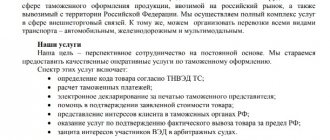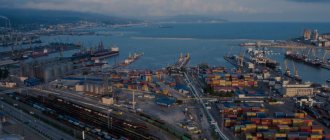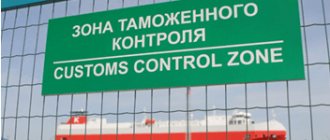Customs value (t/c) is essentially the tax base for calculating the amount of duty and VAT. Due to the fact that customs payments account for up to half of the Russian budget revenue, customs authorities systematically inflate the customs value of imported cargo in order to increase customs payments. For some product groups, the customs value taken for calculating customs duties is several times higher than international commodity prices. There are 6 methods for determining customs value, each of them is applied sequentially when the previous method cannot be applied. The sixth method is a reserve method; the customs value is calculated based on the prices for a given product in the domestic market of the Russian Federation. So the determination methods:
1 method. Based on the transaction value of imported goods, this is currently the most common method for determining vehicle value. The algorithm for calculating customs value is as follows: we sum up the cost of the goods in the country of origin according to the invoice and the cost of delivering the goods to the border of the Russian Federation. The total amount is the basis for calculating customs duties and VAT.
Method 2. Based on the value of a transaction with identical goods - determination of the customs value based on the value of a transaction with identical goods. the value of a transaction with identical goods is taken as the basis for determining the customs value.
Method 3. According to the value of the transaction with homogeneous goods - formally its application does not differ from method 2, with the exception of the concept of homogeneous goods - goods that are not completely identical, but have similar characteristics and consist of similar components, which allows them to perform the same functions as goods being valued and being commercially interchangeable.
Method 4 Based on subtraction of cost - based on the price at which imported (valued) or identical or homogeneous goods were sold in the largest aggregate lot on the territory of the Russian Federation in unchanged condition. In this case, costs typical only for the domestic market are deducted from the price, which should not be included in the customs value (customs duties, ordinary costs in connection with transportation and sale, etc.)
5 method. Based on the addition of value - based on taking into account the production costs of these goods, to which is added the amount of profit and expenses characteristic of the sale of the goods being valued in Russia. Perhaps this is the most difficult method, since few suppliers will agree to provide cost estimates. And then, even after receiving this data, it still needs to be translated into Russian.
6 method. Reserve method - used if it is impossible to determine the customs value using the above methods. Based on calculations and expert assessments, with assessments based to the maximum extent possible on the transaction value of the imported goods; the value used is based on actual estimates, that is, the prices at which imported goods are sold in the country in the normal course of trade under competitive conditions.
In order to determine the customs value, the following documents may be required from the declarant:
- direct contract with the factory
— confirmation of payment to the factory, the amount corresponds to all documents
— export declaration
- invoice
- price list - factory list
— specification annex to the contract with prices
- the official website of the plant with prices and articles that match the data in your documents (this despite the fact that the Chinese generally do not publish prices in open sources, and articles and products are constantly being improved)
— prices on the Chinese domestic market for your products
If you have collected and submitted all this, now do not forget to have this set of documents certified by the Chinese Chamber of Commerce and Industry, they put beautiful blue seals and stitch the papers with red ribbons. Well, the final chord is when the customs authority asks you for a cost estimate for your supplier’s production. In addition, customs still have a lot of opportunities to complicate the life of the importer; adjustments to the customs value can be processed by one or two inspectors who are overwhelmed with work and the declaration will lie for another week, 10 days pass from the moment of submission - it is necessary to withdraw it and submit a new one. Once you have passed this stage, you are welcome to a full inspection with unloading of cargo at the inspection area. And then, the customs inspector still writes to you that the documents confirming the customs value are not enough, he cannot accept the vehicle - he has an oral instruction below the risks not to accept the declaration. The customs value is adjusted to the level of the risk profile, the recipient freezes the additional amount and goes with the documents to the court, where after 6 - 9 months he receives a decision to return the amount of the customs value adjustment. Now take a deep breath and consider whether the game is worth the candle. So, there is a difference between the actual contract value of imported goods and the customs value, which results in additional costs for the importer. By the way, adjustments to the customs value can be made even after the goods are released into free circulation; customs retroactively formalizes the adjustments and sends collection to your bank. The actual condition for applying the first method of determining the customs value is the consent of the declarant to adjust the customs value, or the declarant initially submits a declaration, focusing on the cost, customs risk profile. The release of goods using the first method occurs if customs agrees with the chosen method for determining the customs value and the customs value of the goods. The procedure for declaring customs value is carried out by submitting completed forms to the customs authority - declaration of customs value, which shows the calculation of the cost of the goods, delivery and the chosen method for determining the customs value.
- Method based on transaction value of imported goods
- Transaction value method for identical goods
- Transaction value method for homogeneous goods
- Subtraction method
- Addition method
- Backup method
Guidelines for solving problems
Topic 6 Customs support of logistics activities
Task 2 Determination of customs duties
Purpose of the task: to gain skills in calculating customs duties
.
Tasks
Task 1.
Calculate the amount of customs duties payable upon customs clearance of a consignment based on the following data:
1. The customs value of the consignment is USD 6,300.
2. Batch size - 100 kg.
3. The customs clearance fee is 35 euros.
4. The customs duty rate is 30%, but not less than 6 euros per 1 kg.
5. VAT rate -20%.
Task 2.
Determine the amount of customs duties payable during customs clearance of cargo, based on the following data:
The importing organization entered into a contract for the purchase of bottled beer (with an alcohol content of over 7%) in the amount of 10,000 liters. The purchased beer was delivered to the customs territory of the Republic of Belarus on February 3, 2012. The customs declaration for the imported beer was submitted to the customs authority and accepted by it on February 6. The customs value of imported beer was 6,510 euros. Let us assume that the official exchange rate of the Belarusian ruble to the euro, established by the National Bank of the Republic of Belarus on February 5 (the day of submission of the customs declaration), was (conditionally) 10,000 Belarusian rubles/euro.
Task 3.
Calculate the amount of customs duties payable upon customs clearance of a consignment based on the following data:
The declaration for placing imported raw materials under the customs procedure of processing on the customs territory was registered on May 14, 2011 (1 euro = 4408.27 Belarusian rubles), and the processed product under the customs procedure of release for domestic consumption - on August 5, 2011 (rate, Let's assume the following: 1 euro = 6666.66 Belarusian rubles). The customs value of imported raw materials is 10,000,000 Belarusian rubles, quantity is 100 kg, the rate of import customs duty on such raw materials is 1 euro per 1 kg, value added tax is 20%. The rate of customs duties for customs clearance for raw materials is 20 euros, for finished products - 35 euros.
.Task 4
Determine the amount of payments to be made during customs clearance of a batch of children's clothing made of wool yarn (code 6209100000) in the amount of 700 kg, using the following data (determine the fee rate for customs clearance yourself):
1. Customs value of the consignment - 4000 thousand Belarusian rubles. R.
2. The customs duty is 20%, but not less than 2 euros per 1 kg.
3. The goods are not subject to excise duty.
4. VAT rate -10%.
Guidelines for solving problems
When moving goods across the customs border of the Customs Union and in other cases provided for by the Customs Code of the Customs Union (TCC CU), the following customs duties are paid:
Customs duty;
Customs duties;
Excise duties (if the goods are excisable);
Value added tax (VAT).
The declarant independently calculates the amount of payments due and pays them at the time the goods are accepted for customs clearance or before it. Customs authorities only control the correctness of calculations.
The total amount of customs payments for import customs clearance upon release for domestic consumption is made as follows:
Where
C is the total amount of payments, Sp is the amount of import duties, Csb is the amount of customs duties, Sa is the amount of excise taxes, Snds is the amount of VAT.
Determination of customs duties
For the purposes of calculating customs duties and taxes, the rates in effect on the day of registration of the customs declaration by the customs authority are applied, with the exception of cases provided for by the Customs Code of the Customs Union and (or) international treaties of the member states of the Customs Union (clause 1 of Article 77 of the Customs Code of the Customs Union).
The amount of customs duties depends on what goods are imported. Rates of customs duties are systematized in accordance with the Commodity Nomenclature of Foreign Economic Activity of the Customs Union and are determined by the Unified Customs Tariff of the Customs Union (UCT CU).
Basis for calculus
customs duty is
the customs value
of imported (exported) goods and (or)
the volume of goods in physical terms.
There are three main types of customs duties (Article 71 TMK CU):
— ad valorem rates
- rates set as a percentage of the customs value of goods (for example, 15% of the customs value);
- specific rates,
which are established in value terms depending on the physical characteristics in physical terms (quantity, mass, volume or other characteristics), i.e. for a certain quantitative unit by which a product can be characterized (for example, 2 euros per 1 liter). The monetary expression of specific rates is pegged to euros or US dollars;
- combined rates
— these bets combine the properties of both previous types. They involve the simultaneous use of ad valorem and specific rates or the use of only the one that allows you to obtain a large amount of customs duty (for example, 100%, but not less than 2 euros per 1 liter).
Determination of customs duties
Customs duties are mandatory payments collected by customs authorities for actions related to the release of goods, customs escort of goods, as well as for performing other actions established by the Customs Code of the Customs Union and (or) the legislation of the member states of the Customs Union (clause 1 of Article 72 of the Customs Code of the Customs Union ).
Clause 2 of Article 72 of the Customs Code of the Customs Union establishes that the types and rates of customs duties are established by the legislation of the member states of the Customs Union.
Table Amounts of customs duties for customs operations in the Republic of Belarus
| Code of a group of goods in accordance with the unified HS of the Customs Union | Customs duty rate for customs operations, in euro equivalent |
| 1 — 26, 30, 31, 41 — 70, 72 — 83 | |
| 27 — 29, 32 — 40, 71, 84 — 97 |
Fees are paid on the processed consignment of goods, regardless of the customs value and quantity of imported goods. If there are several items of goods in the batch being processed, then the larger rate provided for these goods is used.
Calculation of excise taxes
A feature of excise taxes is their individualization, i.e. link to specific products. Excise taxes are levied when importing only excisable goods into the territory of the Republic of Belarus. The list of excisable goods is provided for in Art. 111 Tax Code (TC). According to paragraph 3 of Art. 112 of the Tax Code, excise tax rates, including those collected by customs authorities, are established by Appendix 1 to the Tax Code.
When calculating excise taxes, the following types of excise tax rates are applied:
Ad valorem rates,
accrued as a percentage of the cost of goods
Where
Ca – amount of excise taxes
Ba – tax base for goods subject to excise taxes;
A – ad valorem excise tax rate, %
The tax base will be determined by the formula:
Where
T – customs value of the imported goods;
Сп – amount of import customs duty
SSB - amount of customs duty
Firm (specific) rates ,
accrued in the established amount per unit of measurement of goods
Where
Kt – quantity of goods in units of measurement in relation to which the excise tax rate is established (for example, per liter);
A is the established excise tax rate per unit of goods.
The procedure for calculating VAT when importing goods into the customs territory of the Republic of Belarus
When importing goods, VAT is paid, depending on the type of goods imported, at the following rates: 10, 20 percent.
A rate of 10 percent is established for imported food products and goods for children according to the list approved by the President of the Republic of Belarus (subclause 1.2.2, clause 1, article 102 of the Tax Code).
The tax base of the value added tax collected by customs authorities when importing goods into the territory of the Republic of Belarus is determined as the amount of:
— their customs value;
— amounts of customs duties payable;
— amounts of excise taxes payable (on excisable goods) (clause 1 of Article 99 of the Tax Code).
Thus, the amount of value added tax that must be paid to the customs authority is determined by the following formula:
where VAT is the amount of value added tax in Belarusian rubles;
— tax base, the calculation of which involves:
T - customs value of imported goods in Belarusian rubles;
Sp - the amount of import customs duty payable in Belarusian rubles;
Sa - the amount of excise duty payable in Belarusian rubles;
VAT - VAT rate as a percentage (10%, 20).
Tariff benefits in the Republic of Belarus are established by the President of the Republic of Belarus. Currently, the norms of the Decree of the President of the Republic of Belarus dated April 18, 2003 No. 14 “On the establishment of tariff preferences” (as amended by the Decree of the President of the Republic of Belarus dated November 3, 2004 No. 12) are in force, to which lists of countries and goods are presented in relation to which have tariff preferences.
When solving problems, you should use the official exchange rates established by the National Bank of the Republic of Belarus.
- home
- Calculators
- Calculation of customs payment
VAT, RUB — 0
CUSTOMS DUTY, RUB — 0
CUSTOMS FEES, rub — 0
GENERAL CUSTOMS PAYMENTS, rub – 0
*The customs payment must be multiplied by the exchange rate on the day the declaration is submitted; a small amount is often included for exchange rate fluctuations.
**Below is a table for calculating customs duties, in addition to calculating the cost of customs duties.
Features of calculating customs duties:
- Customs fees depend on the cost of the goods + freight transportation.
- Below is a table for calculating customs duties, in addition to calculating the cost of customs duties.
- The VAT rate depends on the type of product, generally it is 20%.
- In cases where your product falls under preference, these are often goods for medical, children's and scientific purposes and the customs clearance rate can be from 0 to 10%.
- VAT = (product price + delivery + customs duty + insurance)*___% VAT.
- Duty = (product price + shipping cost + insurance)* ___% duty.
Fees are calculated according to the table below
| Cost of goods and freight transportation in rubles | customs duty |
| from 0 to 200,000 rub. | 775 rub. |
| from 200,000.01 rub. up to 450,000 rub. | 1550 rub. |
| from 450,000.01 rub. up to 1,200,000 rub. | 3100 rub. |
| RUB 1,200,000.01 up to 2,700,000 rub. | 8530 rub. |
| RUB 2,700,000.01 up to 4,200,000 rub. | 12000 rub. |
| RUB 4,200,000.01 up to 5,500,000 rub. | 15500 rub. |
| RUB 5,500,000.01 up to 7,000,000 rub. | 20,000 rub. |
| 7000000.01 rub. up to 8,000,000 rub. | 23000 rub. |
| 8000000.01 rub. up to 9,000,000 rub. | 25000 rub. |
| 9000000.01 rub. up to 10,000,000 rub. | 27000 rub. |
| from 10000000.01 rub. and more | 30,000 rub. |
According to paragraph 2 of the Resolution of March 26, 2021 No. 342
If the customs value of goods imported into the Russian Federation is not determined and not declared, and also if in relation to goods exported from the Russian Federation (with the exception of goods specified in paragraph 26 of part 1 of Article 47 of the Federal Law “On Customs Regulation in the Russian Federation ”, as well as in paragraphs 8 and 9 of this resolution) the rates of export customs duties are not established or specific rates of export customs duties are established; customs duties for customs operations are paid at the following rates:
- 6 thousand rubles - for customs operations if the number of goods specified in paragraph one of this paragraph in the customs declaration does not exceed 50 goods;
- 12 thousand rubles - for customs operations if the number of goods specified in paragraph one of this paragraph in the customs declaration is 51 goods or more, but not more than 100 goods inclusive;
- 20 thousand rubles - for customs operations if the number of goods specified in paragraph one of this paragraph in the customs declaration is 101 goods or more.







